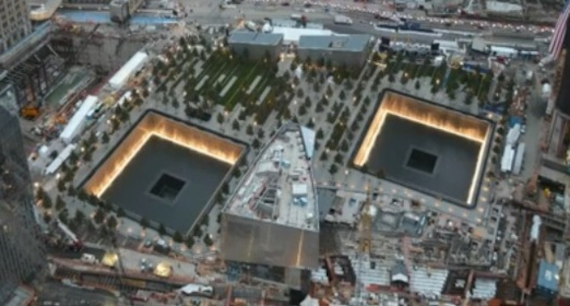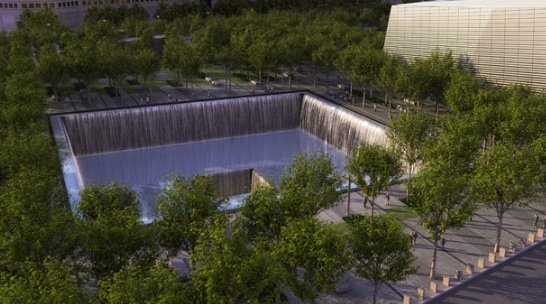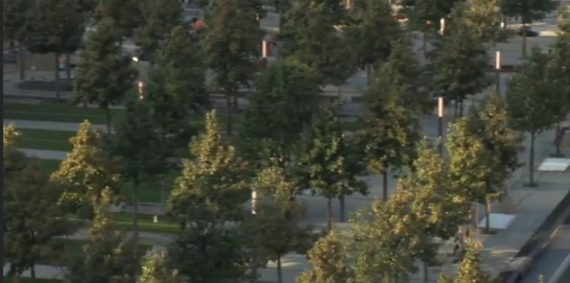This is a review of the 9/11 Memorial by architect Michael Arad. For more detailed biographical and historical information concerning Arad, the commissioning and preparations for this memorial, see "The Memorial Architect: Michael Arad's 9/11 Moment Arrives" by Karen Matthews on Huffington Post.
On the tenth anniversary of the 9/11 attacks, the public will get its first view of Reflecting Absence, Michael Arad's long-awaited memorial to the thousands killed in the Twin Towers, at the Pentagon, on United Airlines flight 93, and in the February 26, 1993 bombing of the World Trade Center. The memorial will undoubtedly greet expectations with as much controversy and bewilderment as the admiration it is apt to attract.
All who come to the Memorial, however, will acutely feel the Absence. Arad has seen to this by making the site something akin to those paintings and stories telling of long departed deities, heroes, and buddhas who, in their departure from earth, left no trace behind but their footprints. In what was the foundations of the majestic towers, Arad has carved out what he calls "voids"--a pair of black granite craters, each 192 x 192 feet square and set 30 feet down into the footprints of the Twin Towers. Each of the cubic voids support falling waters streaming into sunken reflective pools, and further into central, square drainage basins. The pools comprise but a dramatically stark fraction of the eight acres Arad was assigned by Daniel Libeskind's master plan. Landscape architect Peter Walker has covered much of the rest of the memorial park with a grove of elegant white oaks that promise to grow into awe-inspiring cathedrals of arching branches.
That much has so far resonated with the media and the public. And from a highrise or aerial view of the park, the site is something more than satisfying, at least to someone who has traced the rise of the towers from those very foundations floor by floor. To this devoted fan of the towers, the "prints in the sand" sentiment has something of an aura befitting the towers' now-mythical status. On the other hand, as someone who grew up with a love for minimalist and conceptualist sculpture and architecture, I'm an easy mark for Arad's heightened sense of the theatrical virtuosity of minimalism and "truth to materials" functionalism.
The question is, will Arad's Zen-like aestheticism satisfy those visitors not so predisposed to "emptying" themselves of more elaborate and conventional expectations? As musical analogies go, it's the difference between the public expecting Samuel Barber's Adagio for Strings--with its lush, slowly arching and lachrymose ascent to the sun of divine retribution--and getting instead something spatially and visually equivalent to a Phillip Glass concerto, with its spare and repetitively hypnotic chords, quiet instrumentalism, and rhythms that hug the earth. For Reflecting Absence imparts a modest serenity and resolute confidence that leaves its more appreciative audience contemplative and blissfully wanting more--but not aching or in tears.
This is no doubt why interviews and commentaries have strained to make Arad's memorial the metaphorical equivalent of Maya Lin's similarly minimalist Memorial to the Vietnam Veterans in Washington. The trouble isn't that Reflecting Absence isn't evocatively metaphorical. On the contrary. Arad's 9/11 Memorial is more than a metaphor or a monument. It's an embodiment of the spirit and force of Nature we look back to when all the modern armature of civilization has failed to protect us. Whatever the site's resistance to sentimentalism, the physical place has the potential to make itself felt, if not entirely understood, as an embodiment of the forces that left us bereaved, while also bringing catharsis to those maligned by a national--no, an international tragedy. Sadly, there is no easy way for visitors to see the entire memorial laid out before them, preferably on first approach, as say from some elevated observation platform. This is the biggest lapse in judgment considering that the memorial's greatest power is derived from seeing the overall lay of the land with its imposing footprints of the towers from a vista befitting any world-class archeological ruin or sacred site. Prior photographic or video exposure is helpful in orienting visitors, but why should this be expected to stand in for the full sensory experience of taking it all in at one glance in the open air?
In terms of aesthetics and principles of design-in-context, Arad's memorial represents a subtely new approach to the public monument. Since at least the Old Kingdom Egyptians, unless a monument was also an astronomical calendar anticipating its own alignment with some aspect of the sun, moon and stars, monuments were either predominantly abstract forms, like the pyramids of Giza. Or they were somehow narrative in function, as is the frieze of figures carved from the stone of Trajan's column in Rome, depicting as much of the story of a hero and his people as could be crammed in. It is, however, telling that the general public's favorite monuments have long been those comprised of, or arranged in, simple geometric forms and cutting the horizon or surrounding landscape--as do Stonehenge, the pyramids of Giza, and the obelisks of Luxor.
With the mid-20th century proclivity for innovative designs marked by minimalism and an abstract avoidance of themes, the Western monument and memorial reverted back to its most ancient and formalistically-reductive vocabulary. But this time the monument took a metaphorical turn that seems aimed more at the general population than to the artists and architects who have more esoteric expectations. For Americans, this is nowhere better embodied and beloved (however belatedly) than in Maya Lin's Vietnam Veteran's Memorial in Washington, D.C. Like the pyramids or obelisks of the Egyptians, Lin's design represents a return to a formal gestalt--the kind of simple yet forceful iconicism that the mind summons with ease for its basic and memorable contours. But unlike the ancient monuments, the Vietnam Memorial is also intentionally metaphorical in a deeply psychological sense--and really it is poly-metaphorical in lending itself easily to the interpretation each person brings to it.
As a monument that descends and nearly disappears into the ground surrounding it, the Vietnam Memorial metaphorically resembles a combat trench or a sacred burial mound of neolithic warriors. Lin herself analogizes the Vietnam Memorial as a tear or wound in the earth, the kind of poetic injury to sculptural form that the Surrealists would have appreciated. Elsewhere, Lin has referred to her memorial as a kind of book, no doubt a sacred book of the dead. These are motifs that trigger an emotional response that when aligned with the memories of the dead being mourned also amount to a cathartic release of sorrow.
Arad's 9/11 Memorial is related to the minimalism and metaphoria of Lin, but it is much more than a metaphor. Arad's choice of water as the elemental theme of the 9/11 Memorial is the embodiment of a 9/11 wish--the wish so many of us had that sunny morning--that a great water would pour out of the sky and extinguish the great conflagration consuming the towers. Arad's choice of twin waterfalls also embodies the means of our healing from the trauma of 911. Waterfalls and reflecting pools are hypnotic, inducing the calm necessary for contemplation and spirituality.
There is also a potent psychological embodiment in Arad's use of water. Had Arad installed fountains instead of waterfalls, he would have embodied willful defiance--as in water being made by humans to defy gravity. Fountains embody the human will to overwhelm and dominate nature--not the kind of sentiment that embodies the healing of traumatized spirits. The waterfalls, by contrast, is in harmony with nature. Daoists recognize the waterfalls as the embodiment of freely and without resistance submitting to the gravity to which all earthly things, animate and inanimate, must submit. The gravity to which the freefalling bodies of the 9/11 victims and the towers stacking floor upon floor in their plummet downward were forced to submit. It seems impossible to cancel the grief of these images in our mind's eye with waterfalls. But if we listen to the Daoists, we will think of falling water not simply as a metaphor for the submission to a greater force, but as the embodiment of the fusion of the self with that force. The fusion of those who died by gravity while becoming one with it--and by implication, becoming one with the Nature or the God from which gravity proceeds. Even though Arad's waterfalls are artificially sustained--generated by hydraulic pumps discretely placed along and under the perimeter of the towers' footprints--the visible effect desired is that the water is ultimately seen becoming one with the earth's gravitational pull.
The difference between Maya Lin and Michael Arad is a difference between a preference for poetry or literalism. Lin is primarily poetic and symbolic in her approach. She draws similarities or analogies between psychological ideas and physical shapes and materials: a tomb is like a wound in the earth. Arad, by contrast, is literally embodying ideas and principles with physical examples of them in action: force=gravity acting on water; water, sound, and light in proper moderation=human sustenance and healing.
Both approaches can be very potent as art. There is a subtle symbolism at work in Maya Lin's Vietnam Memorial. Drawn to the names of the dead inscribed before them, visitors to the site hardly notice their slow descent to what amounts to a symbol of an embracing grave. And indeed, the Vietnam Memorial is a kind of "burial ground" for grief. Yet some visitors have even expressed feeling psychologically, if momentarily, entombed with their loved one as they come to face his or her name, then reflexively reaching out to touch the inscribed name as if touching their loved one's face.
In Arad's 9/11 Memorial, the experience isn't as bodily-immersive as at Lin's memorial. It is more sensorially stimulative--activated with the sights and sounds of nature. The sound of the cataracts drown out the sound of the traffic, but as one walks away from the pools and into the surround of oaks, the rustling of leaves in unison and the arrival of songbirds on sunny days captivate. Yes, these are simple achievements, but in a megapolis like New York they are a hard won collaboration of humans with nature. But they also require some measure of space and solitude.
In the first years, the overwhelming crowds could ward off any experience of mysticism that we desire of our memorials to the dead. On the other hand, the crowds themselves facilitate healing in mingling and sharing a collective memory that, if the moment and mood of the crowd is right, can redefine the Memorial as a national place of gathering. Either way, it is when the crowds subside that the Memorial will show its architect to be keenly aware that however modern and urbane people become, we still unconsciously, if romantically, demand spiritualism from whatever human interface with nature is set aside for that purpose. Any architect disciplined in history should understand this, given that architecture, like art, is a discipline that arose out of religious imperatives imposed on the early builders of cities by priests and priestesses.
That Arad's memorial recalls the mysticism of absence despite its being surrounded by skyscrapers isn't surprising given it is designed by an architect who grew up in a nation as keenly aware as Israelis are of the relationship between the religious site and the environment surrounding it. Israelis also have a good deal to teach us about what it means to revisit a site whose history is capable of triggering both anger and mitigating the lingering trauma and loss inflicted by a violent cataclysm. To my knowledge, Arad hasn't publicly expressed his sentiments on the relationship between architecture, culture, holocaust and mysticism, but his design expresses a sensitivity to all four sensibilities. Still, no one critic can make proclamations concerning whether a memorial site succeeds in mitigating the lingering trauma and loss of an act of war for the public. Spiritual sustenance and healing is exceedingly personal, and it will take years and tens of millions of visitors to tell us whether the site succeeds in this rite for the majority.
By spirituality I mean what a mystic I once met defined as "letting go," a release of the traumas that keep us prisoner to fear. A release of the 2983 victims who lost their lives in the terrorism of 9/11 and the 1993 bombing. A release of our self-identification as victims. In the universal sense, how much we let go can be determined by how willing or reluctant we are to make the 9/11 Memorial our personal and public altar. I mean in the ancient sense of the altar as a place of sacrifice, whether before a God, some Life Force, the implacable Universe, or oneself.
The great difference at Reflecting Absence is the sacrifice need not be made again; it was already made for us and made against our wills. All the more reason that we who survived remember the terror. But we are also wise to fuse our terror to the beauty and serenity supplied by Arad's memorial as a means by which we consecrate (by rite of faith or reason) that amalgam of the terror and the healing we can only know at those places we deem sacred ground. "Instill some joy and gladness into me," Psalm 51 sings out in a verse few among believers and disbelievers would fight over. "Let the bones You have crushed rejoice again."
This post was altered by the author on 5/27/16 to reformat the photography and photo captions to the new Huffington Post format. No text or photographs were altered.
Listen to G. Roger Denson interviewed by Brainard Carey on Yale University Radio.
Read other posts by G. Roger Denson on Huffington Post in the archive.
Follow G. Roger Denson on Facebook.











